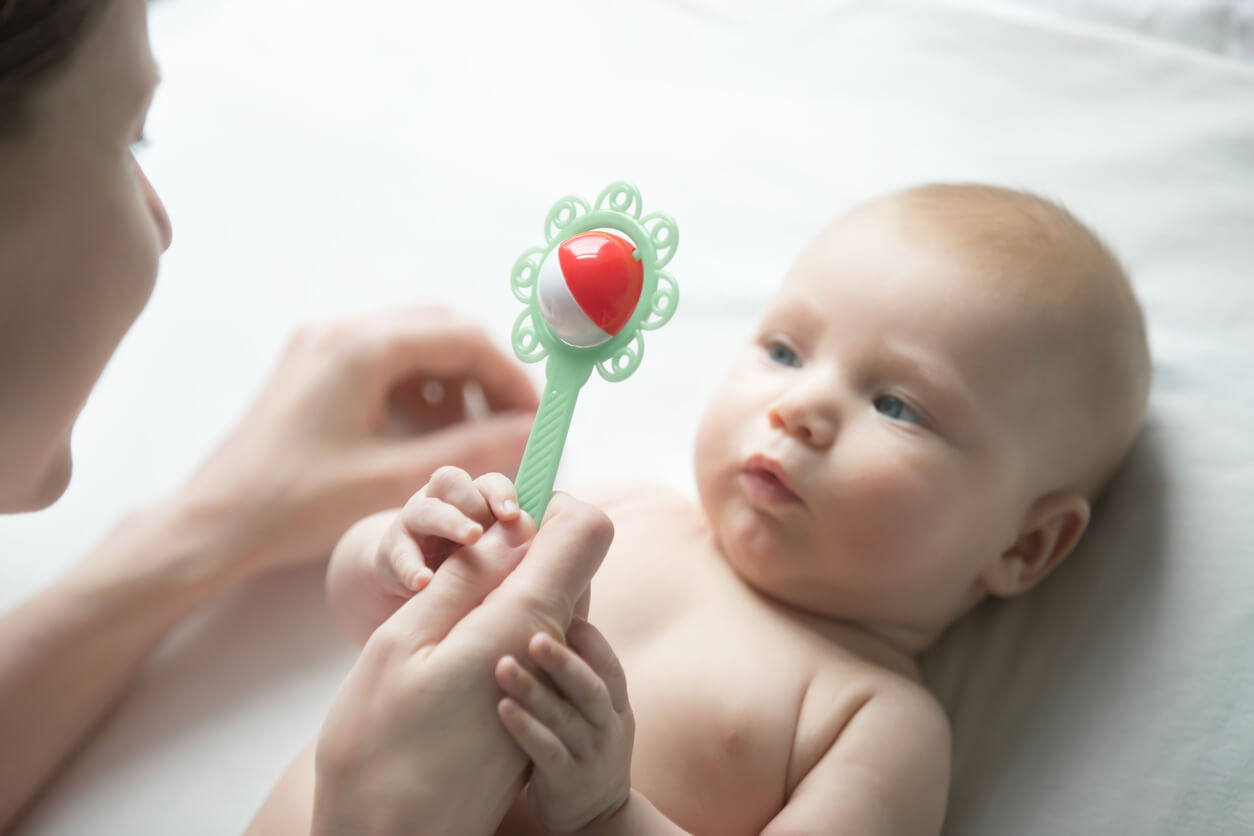How Long Children Can Stay Focused, Depending on Their Age


Written and verified by the psychologist Elena Sanz Martín
The ability of children to stay focused is a matter of concern for many parents. When they see that their children are easily distracted, they may become alarmed and wonder if there’s some sort of attention deficit. The truth is that this is a complex ability that develops progressively. Sometimes, we demand more from our children than they’re able to give. For this reason, it’s useful to know how long children can maintain their concentration according to their age.
This concern is legitimate if we take into account that there’s more and more talk about ADHD. However, a child who’s distracted while reading, who changes activities or games frequently, or who gets up all the time while doing homework, doesn’t necessarily have this condition. This disorder is often overdiagnosed even by professionals. Therefore, before labeling a child, we should check whether their attention corresponds to what’s expected for their age group.
How long can children stay focused?
Attention and concentration are two essential functions during childhood, as learning depends on them. Children progressively gain more control over their attentional resources and are able to stay focused for longer. However, this depends on their development and brain maturation. It’s not a process that can be forced.
If you want to know how long your child should be able to concentrate, here’s an estimate according to age:
The first year of life
During the first year of life, a baby’s attention is fleeting and fickle. The infant may focus on the face or voice of their caregivers, but quickly becomes distracted by any environmental stimulus. Their attention span doesn’t exceed 4 to 5 minutes.

1 to 2 years of age
At this time, children tend to focus their attention on what they’re curious about or whatever manages to catch their attention. They still can’t intentionally stay focused, and concentration isn’t sustained for more than 6 or 8 minutes.
From 2 to 3 years of age
From this stage on, voluntary attention develops and the infant’s already able to control where they put their attentional focus. The ability to concentrate also increases, but it’s still limited and is around 10 to 15 minutes.
From 3 to 4 years of age
Attention control increases. At this age, your child will already be able to shift their attention at will and can stay focused for about 15 to 20 minutes. This is especially true if the stimulus or task is to their liking. However, it’s easy for them to get tired and want to change to a new activity if the current one doesn’t appeal to them.
4 to 5 years of age
At this age, a child may be able to concentrate for up to 25 minutes (although it’s usually less). They also begin to use divided attention, so they pay attention to several things while concentrating on one task. For example, they can listen to you and answer your questions while playing with play dough.
From 6 to 9 years old
By school age, children’s ability to concentrate increases significantly. A child of this age can sustain their attention on a task for periods of 30 to 45 minutes. In addition, they can deliberately attend to a task or activity, even if they don’t like it. These are two very important advances in academic learning.
However, it’s still possible for children to become distracted for much shorter periods of time if they’re bored. When this happens, they may want to change activities or need short breaks in between.

10 years of age and older
From this age onward, children and young adults are able to concentrate for longer and longer periods of time, from 50 minutes to over an hour. Despite the distraction, they can refocus and continue on task. However, as with adults, this will depend on the activity. Moreover, even at this stage, mental breaks will be necessary.
How to help children stay focused
As you can see, children’s ability to stay focused on a task increases progressively as they get older. This is related to the maturation of the prefrontal cortex, which is a brain area that doesn’t finish developing until after adolescence. For this reason, it’s important to be patient and aware of the child’s evolutionary stage in order not to demand more from them than they’re able to achieve.
In any case, there are certain ways in which we can enhance the attention and concentration of little ones. Here are some examples:
- Encourage motivation: Attractive and pleasant activities awaken curiosity and enhance the concentration of little ones. Therefore, it’s a good idea to try to approach tasks in an original way that motivates them to get involved.
- Take into account circadian rhythms and the state of needs: There are certain times of the day when a child is more able to concentrate than others. If they’re sleepy, hungry, tired, or irritable, their concentration won’t be the best and this won’t be the ideal time to try to get them to stay focused
- Pay attention to the environment: If you want your child to stay focused, it’s important for the environment to be free of distractions and irrelevant stimuli. For example, having the television in the background or the rest of the siblings playing in the same room can be major distractions. A cluttered, dirty, or poorly lit space can have the same effect.
- Organize times: The goal is to motivate children to finish the task they’ve undertaken, but they may well need to take breaks. These can be scheduled according to the above information on concentration time according to age. After resting for a few minutes, they can resume their task.
Finally, we can’t overlook the effect that screens and technology have on children. Mobile devices, apps, and social networks affect their ability to concentrate, so it’s important to limit their use. On the contrary, some activities such as breathing techniques, painting mandalas, putting together puzzles, or copying drawings stimulate this function, making them an excellent entertainment alternative.
The ability of children to stay focused is a matter of concern for many parents. When they see that their children are easily distracted, they may become alarmed and wonder if there’s some sort of attention deficit. The truth is that this is a complex ability that develops progressively. Sometimes, we demand more from our children than they’re able to give. For this reason, it’s useful to know how long children can maintain their concentration according to their age.
This concern is legitimate if we take into account that there’s more and more talk about ADHD. However, a child who’s distracted while reading, who changes activities or games frequently, or who gets up all the time while doing homework, doesn’t necessarily have this condition. This disorder is often overdiagnosed even by professionals. Therefore, before labeling a child, we should check whether their attention corresponds to what’s expected for their age group.
How long can children stay focused?
Attention and concentration are two essential functions during childhood, as learning depends on them. Children progressively gain more control over their attentional resources and are able to stay focused for longer. However, this depends on their development and brain maturation. It’s not a process that can be forced.
If you want to know how long your child should be able to concentrate, here’s an estimate according to age:
The first year of life
During the first year of life, a baby’s attention is fleeting and fickle. The infant may focus on the face or voice of their caregivers, but quickly becomes distracted by any environmental stimulus. Their attention span doesn’t exceed 4 to 5 minutes.

1 to 2 years of age
At this time, children tend to focus their attention on what they’re curious about or whatever manages to catch their attention. They still can’t intentionally stay focused, and concentration isn’t sustained for more than 6 or 8 minutes.
From 2 to 3 years of age
From this stage on, voluntary attention develops and the infant’s already able to control where they put their attentional focus. The ability to concentrate also increases, but it’s still limited and is around 10 to 15 minutes.
From 3 to 4 years of age
Attention control increases. At this age, your child will already be able to shift their attention at will and can stay focused for about 15 to 20 minutes. This is especially true if the stimulus or task is to their liking. However, it’s easy for them to get tired and want to change to a new activity if the current one doesn’t appeal to them.
4 to 5 years of age
At this age, a child may be able to concentrate for up to 25 minutes (although it’s usually less). They also begin to use divided attention, so they pay attention to several things while concentrating on one task. For example, they can listen to you and answer your questions while playing with play dough.
From 6 to 9 years old
By school age, children’s ability to concentrate increases significantly. A child of this age can sustain their attention on a task for periods of 30 to 45 minutes. In addition, they can deliberately attend to a task or activity, even if they don’t like it. These are two very important advances in academic learning.
However, it’s still possible for children to become distracted for much shorter periods of time if they’re bored. When this happens, they may want to change activities or need short breaks in between.

10 years of age and older
From this age onward, children and young adults are able to concentrate for longer and longer periods of time, from 50 minutes to over an hour. Despite the distraction, they can refocus and continue on task. However, as with adults, this will depend on the activity. Moreover, even at this stage, mental breaks will be necessary.
How to help children stay focused
As you can see, children’s ability to stay focused on a task increases progressively as they get older. This is related to the maturation of the prefrontal cortex, which is a brain area that doesn’t finish developing until after adolescence. For this reason, it’s important to be patient and aware of the child’s evolutionary stage in order not to demand more from them than they’re able to achieve.
In any case, there are certain ways in which we can enhance the attention and concentration of little ones. Here are some examples:
- Encourage motivation: Attractive and pleasant activities awaken curiosity and enhance the concentration of little ones. Therefore, it’s a good idea to try to approach tasks in an original way that motivates them to get involved.
- Take into account circadian rhythms and the state of needs: There are certain times of the day when a child is more able to concentrate than others. If they’re sleepy, hungry, tired, or irritable, their concentration won’t be the best and this won’t be the ideal time to try to get them to stay focused
- Pay attention to the environment: If you want your child to stay focused, it’s important for the environment to be free of distractions and irrelevant stimuli. For example, having the television in the background or the rest of the siblings playing in the same room can be major distractions. A cluttered, dirty, or poorly lit space can have the same effect.
- Organize times: The goal is to motivate children to finish the task they’ve undertaken, but they may well need to take breaks. These can be scheduled according to the above information on concentration time according to age. After resting for a few minutes, they can resume their task.
Finally, we can’t overlook the effect that screens and technology have on children. Mobile devices, apps, and social networks affect their ability to concentrate, so it’s important to limit their use. On the contrary, some activities such as breathing techniques, painting mandalas, putting together puzzles, or copying drawings stimulate this function, making them an excellent entertainment alternative.
All cited sources were thoroughly reviewed by our team to ensure their quality, reliability, currency, and validity. The bibliography of this article was considered reliable and of academic or scientific accuracy.
- Azócar, M.B; Campos, A.; Chacón, C.; Doggenweiler, S.; Pequeño, M. P. ; Rosas, D.; Vilela, A. y Weason, F. (2013). Proyecto de activación de la atención y concentración, mediante estrategias complementarias, como herramientas para el acceso al aprendizaje, para niños y niñas en su primera etapa de enseñanza básica. Universidad Andrés Bello. Facultad de Humanidades y Educación. Escuela de Psicopedagogía. Santiago de Chile.
- García Peñas, J. J., & Domínguez Carral, J. (2014). ¿Existe un sobrediagnóstico del trastorno de déficit de atención e hiperactividad (TDAH)?.
- Triskier, F. J. (2006). Algunas especulaciones respecto a las modificaciones neurobiológicas durante la adolescencia. VERTEX, Revista Argentina de Psiquiatría, 17(70), 424.
This text is provided for informational purposes only and does not replace consultation with a professional. If in doubt, consult your specialist.








